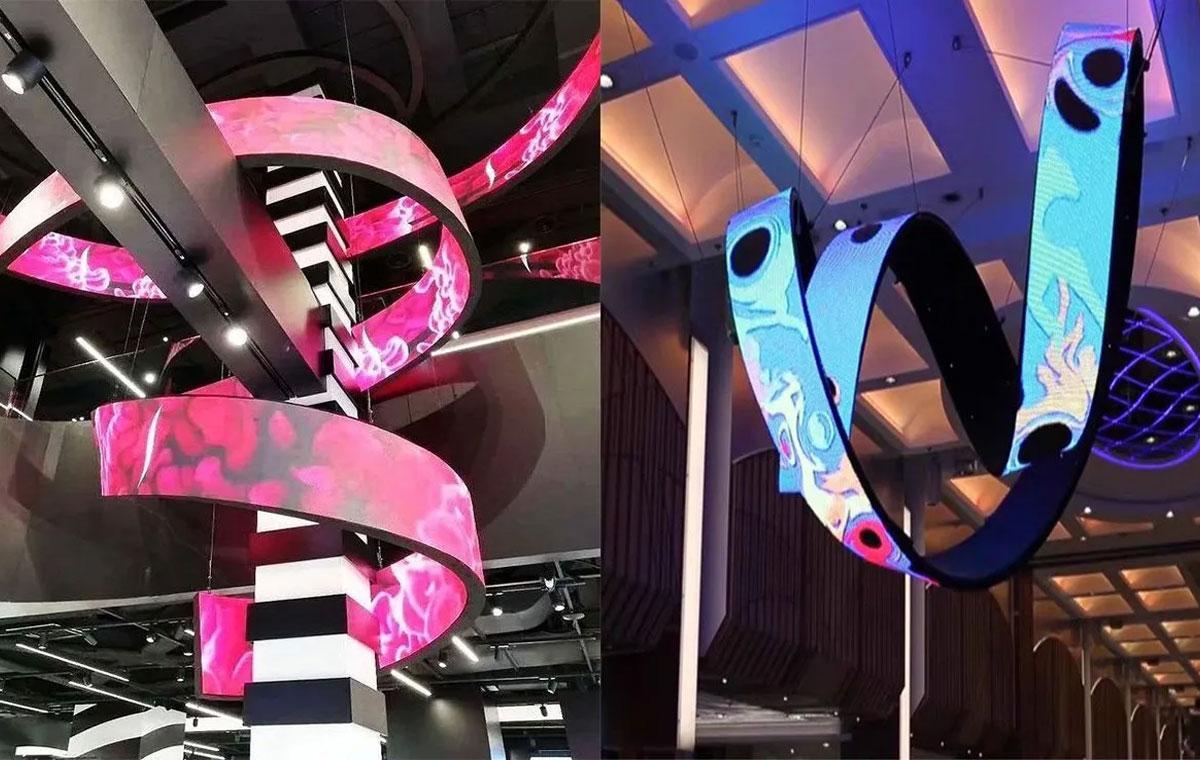Understanding the Flexible LED Display
Flexible LED screens are an advanced visual technology that offers display solutions that are both bendable and lightweight. The screens utilize flexible materials and innovative circuit designs to ensure that they are not physically or technically damaged, even when bent.
Flexible LED screens show their potential for diverse and creative applications in the field of art installations. These screens can be molded into cylindrical, curved, or even flexible LED display films. Overall, they are suitable for a wide range of environments and offer excellent resolution and color accuracy.
Core Characteristics of Flexible LED Screens
Understanding the characteristics of flexible LED screens is critical to ensuring their effective use and long-term performance. Considering color accuracy, resolution, material selection, construction, and composition are key points that must be considered when evaluating. The following is an in-depth analysis.
Material Selection
The thin design of flexible LED screens allows them to flex to varying degrees depending on the nature of the materials used. Typically, flexible LED screens that utilize advanced materials such as polymers perform best.
Transparent flexible LED screens not only bend and fold without damage, but their thin and flexible nature reduces the weight burden and makes installation easier.
Color Accuracy
Color accuracy is an important feature of a screen, as it is able to render colors in precise shades. Typically, ultra-thin flexible LED screens utilize advanced technology to display vibrant and consistent color effects.
Resolution
In order to display clear and sharp images, flexible LED screens require high resolution. Therefore, a high pixel density per unit area is essential for realizing complex graphics, text and visual effects. This provides a realistic and vivid visual experience. Image quality and brightness levels are essential for creating appealing visual effects.
Construction
The ultra-lightweight design of flexible LED screens improves the adaptability, portability and ease of installation of visual technology. Its ultra-thin design reduces distractions, simplifies installation and is easily portable for repositioning in environments with complex space requirements.
Viewing Angle
Viewing angle refers to the visible range of the image on the screen. Ultra-thin flexible LED screens have a wider viewing angle than traditional screens, typically 160 to 178 degrees.
This wide viewing angle allows viewers to see images from multiple angles. Overall, flexible LED screens are able to appeal to a wider range of viewers from different locations, which may result in a higher ROI.
Flexible LED Display Technology in Multiple Environments
Flexible LED display solutions are used in a variety of applications including science and technology museums, entertainment venues, shopping malls, exhibitions and art galleries. This display technology is ideally suited to attract customer attention due to its wide viewing angles and flexible design possibilities.
Artistic Display
Through innovative shape and mold design, flexible LED screens push the boundaries of convention to effectively engage and captivate audiences. They are ideal for creating visual narratives, interactive sculptures and dynamic paintings.
Flexible LED screens can display engaging video content, which often has a unique shape. Overall, these screens are ideal for going beyond traditional display options with their innovative, personalized, and visually strong impact. Flexible LED displays are able to convey abstract concepts, narratives, and emotions, thus enhancing the persuasive power of visual storytelling.
Ultra-thin flexible LED screens enable retailers to display promotional messages, brand stories and product details. Their shape and size can be easily adapted to a variety of business environments to enhance the shopping experience and engage customers. In addition, the flexibility, high resolution and vivid colors of these flexible LED screens make marketing campaigns more impactful.
As a result, they capture the attention of shoppers and have a long-term positive impact on brand image. These screens are lightweight and ideal for complex retail environments where space is limited. As a result, the use of flexible LED screens improves customer engagement and increases the return on investment.
Entertainment and Events
In the entertainment industry, visuals are in high demand for shadows, light and sound. Flexible LED screens can adapt greatly to these needs, transforming stage backdrops and enhancing live performances. This technology can be used to seamlessly integrate into a variety of visual scenarios and redefine color accuracy.
Whether it's a company party, a holiday celebration or a concert, innovative LED screen applications can create unforgettable moments. These dynamic backdrops not only enhance the visual experience, but also increase the level of audience participation, thus improving the overall quality of the performance.
Science Museums
Flexible LED screens are ideal for bringing interactive exhibits, historical narratives and science demonstrations to life. These displays transform static exhibits into compelling presentations. The use of flexible LED display screens makes complex scientific information easier to understand and attracts more interest from visitors.
Additionally, due to their high resolution, these screens are suitable for displaying astronomical explorations, microscopic worlds and intricate details. They also function as educational outreach, with the curved screen design making it easy for viewers to learn about various topics through engaging video content.
Post time: Jul-17-2024








